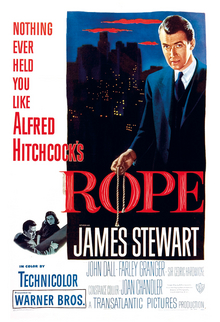Critical response
Contemporary reviews were mixed. Variety wrote:
Hitchcock could have chosen a more entertaining subject with which to use the arresting camera and staging technique displayed in Rope ... The continuous action and the extremely mobile camera are technical features of which industry craftsmen will make much, but to the layman audience effect is of a distracting interest. [28]
Bosley Crowther of The New York Times wrote:
The novelty of the picture is not in the drama itself, it being a plainly deliberate and rather thin exercise in suspense, but merely in the method which Mr. Hitchcock has used to stretch the intended tension for the length of the little stunt. And, with due regard for his daring (and for that of Transatlantic Films), one must bluntly observe that the method is neither effective nor does it appear that it could be. [29]
The Chicago Tribune 's Mae Tinee was candid about her reactions:
If Mr. Hitchcock's purpose in producing this macabre tale of murder was to shock and horrify, he has succeeded all too well. The opening scene is sickeningly graphic, establishing a feeling of revulsion which seldom left me during the entire film....Undeniably clever in all of its aspects, this film is a gruesome affair and—to me, at least—was a gruelling spectacle, not recommended to the sensitive. [30]
John McCarten of The New Yorker wrote:
In addition to the fact that it has little or no movement, Rope is handicapped by some of the most relentlessly arch dialogue you ever heard. [31]
The Monthly Film Bulletin found that the actors, "for the most part, are excellent", but that, "as a film, much of the suspense of the story and the drama of the original written material has been lost because the continual movement within a confined space, although more fluid, is slower and more tiring to watch than a film which has been edited by the conventional method." [32]
Harrison's Reports gave the film a very positive review, calling it "an exceptionally fine psychological thriller" with "excellent" acting and "an ingenious technique, and under Hitchcock's superb handling it serves to heighten the atmosphere of mounting suspense and suspicion". [33]
Edwin Schallert of the Los Angeles Times wrote:
It is unusual enough to shine more as a technical tour de force than as a moving sort of film ... The interesting experimental values in this Hitchcock production could never be denied, yet I would not rate it one of his best. [34]
In Time 's 1948 review, the play that the film was based on is called an "intelligent and hideously exciting melodrama" though "in turning it into a movie for mass distribution, much of the edge [is] blunted" explaining:
Much of the play's deadly excitement dwelt in [the] juxtaposition of callow brilliance and lavender dandyism with moral idiocy and brutal horror. Much of its intensity came from the shocking change in the teacher, once he learned what was going on. In the movie, the boys and their teacher are shrewdly plausible but much more conventional types. Even so, the basic idea is so good and, in its diluted way, Rope is so well done that it makes a rattling good melodrama. [35]
On its theatrical release in 1948, Rope performed poorly at the box office. In Rope Unleashed, screenwriter Arthur Laurents attributed this failure to audience uneasiness with the homosexual undertones in the relationship between the two lead characters. [27]
Nearly 36 years later, Vincent Canby, also of The New York Times, called the "seldom seen" and "underrated" film "full of the kind of self-conscious epigrams and breezy ripostes that once defined wit and decadence in the Broadway theater"; it is a film "less concerned with the characters and their moral dilemmas than with how they look, sound and move, and with the overall spectacle of how a perfect crime goes wrong". [15]
Roger Ebert wrote in 1984: "Alfred Hitchcock called Rope an 'experiment that didn't work out', and he was happy to see it kept out of release for most of three decades", but Ebert went on to say that "Rope remains one of the most interesting experiments ever attempted by a major director working with big box-office names, and it's worth seeing ...." [11]
A BBC review of the DVD release, in 2001, called the film "technically and socially bold" and pointed out that given "how primitive the Technicolor process was back then", the DVD's image quality is "by those standards quite astonishing"; the release's "2.0 mono mix" was clear and reasonably strong, though "distortion creeps into the music". [36]
Rope holds a score of 93% on the review aggregation website Rotten Tomatoes based on 57 reviews, with an average rating of 7.7/10. The site's critical consensus reads: "As formally audacious as it is narratively brilliant, Rope connects a powerful ensemble in service of a darkly satisfying crime thriller from a master of the genre". [37] Metacritic, which assigns a weighted average, reports a score of 73 out of 100 based on reviews from ten critics, indicating "generally favorable reviews". [38]












